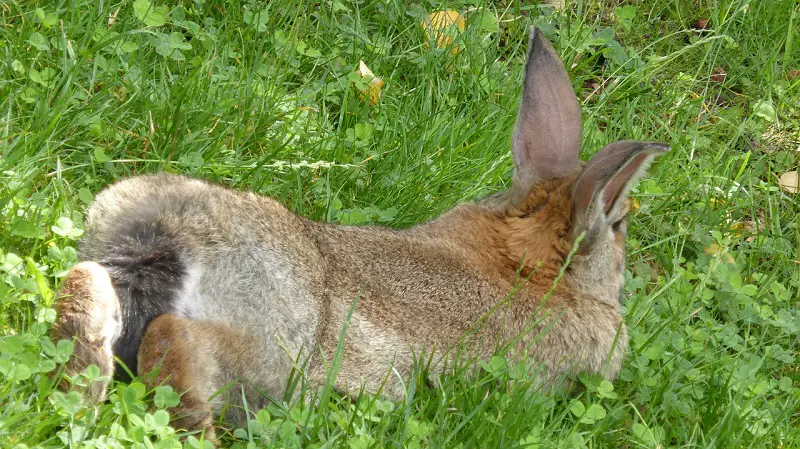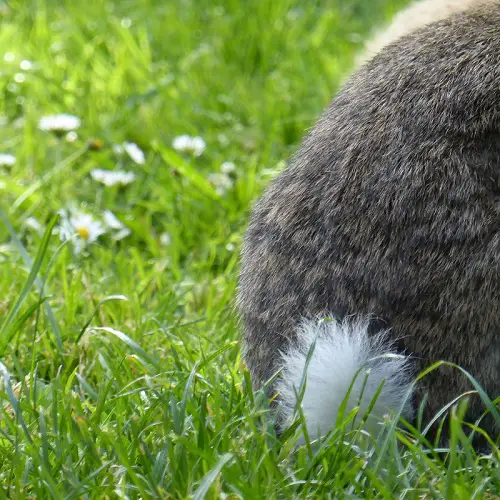Last Updated on June 12, 2023 by Laura Thompson
Have you ever wondered what rabbit tails are for? After all, they seem to be so short to make any difference and if you look at wild rabbits, they’re white, isn’t that a bit counterintuitive? The truth of the matter is the white fluffy tails of rabbits go a long way to ensuring their survival as a species.
Rabbit tails have a white underside and its color, although can attract predators, is also used to confuse them. Rabbit tails are also used to signal to other rabbits as one last stand against the predators.
If this fact has gotten your attention then great, that was my intention all along. This article will give you all the amazing facts about rabbit tails and how they’re more than just cute appendages.
Rabbit tails are lifesavers for wild rabbits and while your domestic rabbit might not have the same use for them, rabbit tails also play a big part in bunny body language.

What is a scut and what is it made of?
A long, long time ago a rabbit’s tail is called a “scut”. This word means “short and erect” which is apt because that’s what a rabbit’s tail looks like. A rabbit’s tail is also not made up of fur. It is made up of bones that are connected to the spine.
Rabbit tails are extremely sensitive and need to be taken care of. For rabbits in the wild, the loss of their tail will almost mean death for them as they will lose one of their greatest advantaged against their natural predators.
What does a rabbit tail look like and do all rabbits have tails?
A rabbit’s tail can differ depending on whether the rabbit is a wild rabbit or a domestic rabbit. One important thing to remember is that domestic rabbits are bred selectively therefore it should not surprise you if their tails do not look like the tails of their wilder cousins.
Wild rabbits always have a white underside to their tails, for Cottontail rabbits, their tails are purely white. Domestic rabbits, on the other hand, can have white tails but most of them take the same color as the rabbit’s coat.
Also, all rabbits have tails. You might think that your Netherland Dwarf or your Dwarf Hotot doesn’t have tails but they do, they’re just really small and close to their bodies.
Rabbits generally have their tails close to their bodies and that’s why they can keep them safe and injury-free. Tails are noticeable when your rabbit is lying sprawled on the floor on their stomachs and their legs stretched behind them. This allows for the rabbit tails to stretch and will be easier for you to see.
How can a Rabbit’s tail save its life?

For domestic rabbits, a rabbit’s tails are used mainly as part of their body language for wild rabbit’s however a tail their tails are used to save their lives and the lives of their colony. This might seem confusing for you at first because if a rabbit’s tail helps them with survival why then does it stick out so much?
You see wild rabbits usually come in earthy colors, unlike their domestic cousins who enjoy different coat colors. Their coats after all need to adapt to their environment. Their coats can help them camouflage in their surroundings and their tails, agreeably make them harder to blend in but it also helps them escape their predators.
According to Dirk Semmann of the University of Gottingen in Germany, the white rabbit tails should have a purpose because according to the law of evolution, if white tails were so detrimental to rabbits they would not exist at all. So, he devised an experiment.
In the experiment, he asked humans to track a white dot or a dark dot against a backdrop of green. He found out that people made more mistakes following the white dot than the dark dot. This coincides with his experience of trying to follow a Cottontail rabbit.
He found out that as he was trying to follow the rabbit’s white tail he found it harder to guess where the rabbit went. This is how the white tail of the rabbit has been widely believed to be successful in evading predators as it confuses them rendering them unable to follow.
Rabbit tails are also used to signal other rabbits that danger is present. Rabbits will sit and raise their tails and the white underside will be a signal for other rabbits to run to safety.
You might think that a rabbit who does this will surely die because then if it sits there with its tail up, then how can it run? You are right in this, rabbits who do this are usually those that can no longer outrun their predators due to injury or other factors. This is their last stand against their predators, to ensure that others get saved.
Pretty amazing don’t you think? Rabbits are truly one of the most interesting creatures that we are lucky to have on earth.
What is a purpose of a tail for Domestic rabbits?

Although domestic rabbits are not in immediate danger of predators their tails still serve the purpose of exhibiting what they feel. Observing the behavior of your rabbit’s tail will tell you tons about their moods and feelings
Rabbit tail wags
This is usually a sign of irritation or discomfort. Rabbits who are displeased usually wag their tiles. Rabbits will also wag their tails to show their displeasure about other rabbits.
So if you find that your rabbit wags its tail in the presence of another rabbit then it’s most probably because they don’t like the other bunny
Rabbit with a raised tail
A raised tail in a domestic rabbit can be a sign of aggression or merely that your rabbit is about to go to the bathroom. A raised tail matched with vocal cues means it’s about to lunge or bite while just tail on an otherwise calm rabbit means, they’re about to pee.
Rabbit with a lowered tail
T this means that your rabbit is unsure of its surroundings. A cautious rabbit will approach things slowly with its legs stretched out behind them and its tails lowered.
Conclusion
Rabbit’s tails are effective means for them to avoid predators (for wild rabbits) and to show you how they feel (domestic rabbits).
While domestic rabbits might not need them as much, it’s still important that you take care of their tails as they are sensitive appendages and will cause your rabbit great pain if injured.
Laura is an experienced wildlife rehabilitator and conservationist residing in Madison, Wisconsin. Her love for rabbits was sparked during her early career when she nursed an injured wild rabbit back to health. Today, she runs “Hoppy Haven”, a rehabilitation center dedicated to the care and release of injured wild rabbits.
